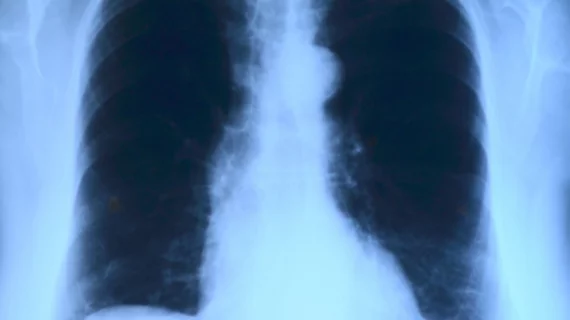Radiology residents are proficient in CT, but struggling to read x-rays
Radiology residents are able to adequately detect an abnormal chest x-ray (CXR) from a normal one, according to research published in Diagnostic and Interventional Imaging, but the demographic lacks a theoretical background in CXR that would improve those residents’ abilities to make an accurate diagnosis.
Though it’s been around for decades, chest x-ray remains the most commonly used imaging modality worldwide, C. Fabre, of the University Hospital of Angers in France, and colleagues wrote. An increasing emphasis on computed tomography, however, means radiology residents are often exposed more to new technologies and less to old-school techniques.
“Numerous studies have shown that CXR remained critical for decision-making and that a wrong interpretation could adversely modify patient management,” Fabre et al. said. “Paradoxically, CXR reading is less and less taught today, even though it is one of the more demanding in terms of cognitive load and experience.”
The authors said that recently, the French College of Radiology Teachers offered just one 30-minute lecture on CXR during a years-long theoretical training course. Last year, the European School of Radiology ignored CXR-specific training entirely.
“Now that clinical practice evaluation, certification processes and quality performance measurements take an increasingly important place in healthcare, it is necessary to have the same level of requirement for CXR teaching as for cross-sectional imaging techniques,” Fabre and co-authors wrote.
They said approaches like e-learning, problem-solving, interactive classrooms and simulation medicine could all aid in engaging radiology residents in CXR education, but before anything can be successfully implemented, the field needs to gauge what residents already know.
The team evaluated 81 radiology residents in France through a three-pronged test set designed to mobilize detection and interpretation skills during a CXR reading. Participants were asked to answer three questions: whether the findings were normal or abnormal, whether the case required an additional CT study and what the final diagnosis was. Residents’ answers were compared to an expert’s.
Detection results were “excellent”, Fabre and colleagues said, with a resident success rate of 90.4 percent. Interpretation skills seemed to be more lacking, with a success rate of 76.6 percent, and residents identified diagnosis correctly just half of the time.
“These results show that a majority of radiology residents have a general background in CXR, allowing the achievement of less-elaborate tasks such as distinguishing normal from abnormal findings,” the authors wrote. “However, the rather poor performances of residents to provide a diagnosis, especially for abnormal CXR, is a first signal suggesting room for improvement in teaching chest radiography.”
One of the factors associated with interpretive success was previous attendance at a CXR training course, the researchers said. The number of chest X-rays a resident read per week wasn’t associated with improved—or reduced—detection skills.
“This study shows that radiology residents lack theoretical background in CXR reading, and demonstrates the role of training course in improving residents’ skill related to interpretation task,” Fabre et al. said. “Results suggest promoting systematic CXR theoretical training courses in the curriculum of radiology residents.”

